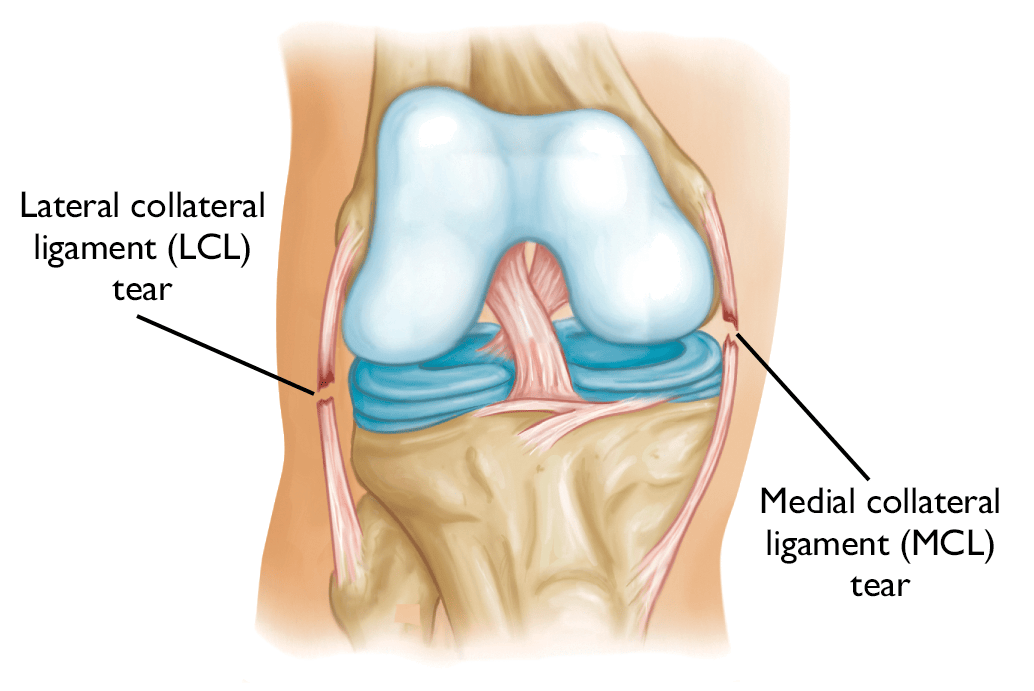
Understanding Knee Tears: Collateral Ligament Injuries
In last week’s post, we began discussing knee ligament tears, starting with the cruciate ligaments, specifically the ACL and PCL. Today, we will be continuing with the remaining two major knee ligaments, the MCL (Medial Collateral Ligament) and LCL (Lateral Collateral Ligament). Like in our last post, I will be primarily summarizing these ligaments and their respective injuries. In the future, I may dive into greater detail with each one of these ligaments and their rehabilitation. This post will highlight the MCL and LCL, how tears occur, associated symptoms, and generally how recovery/rehabilitation works.
What Are the MCL and LCL?
The MCL and LCL are counterparts to each other. The MCL is located on the inner side of the knee, connecting the thigh bone (femur) to the shin bone (tibia). It helps prevent the knee from bending inward (a valgus force on the knee). The LCL is on the outer side of the knee. It connects the femur to the smaller bone in the lower leg (fibula) and helps keep the knee from bending outward (a varus force).
Both ligaments are essential for knee stability, especially during movements like cutting, pivoting, or changing directions quickly. When these ligaments are torn, it can lead to pain, instability, and difficulty participating in physical activities.
Causes, Symptoms, and Grades of MCL and LCL Tears
These injuries usually result from direct impact or sudden twisting motions:
MCL Tear Causes:
- A direct blow to the outside of the knee (common in football or soccer)
- Sudden changes in direction, or overstretching the inner knee
- An awkward fall
LCL Tear Causes:
- A direct blow to the inside of the knee,
- Hyperextension or severe twisting of the knee
The MCL is one of the most common ligament injuries at the knee, while isolated LCL tears are amongst the least common injuries at the knee.
Symptoms to Monitor:
While MCL and LCL injuries share similarities, their symptoms often occur on opposite sides of the knee. They are usually accompanied by pain and tenderness to the affected side, reduced range of motion at the knee, and potential swelling and bruising over the region of the ligament. Some patients report they have a feeling of instability or the knee “feels loose”, while many others report difficulty walking or bending their knee.
Grades of Ligament Tears:
Similar to the ACL and PCL tears, the MCL and LCL tears are usually graded based on severity:
- Grade I: Mild sprain or stretching, minor pain, and no instability
- Grade II: Partial tear, more noticeable pain and swelling, some instability
- Grade III: Complete tear, severe pain (at first), and significant joint instability
Treatment:
Fortunately, most MCL and LCL injuries can heal without surgery, especially lower-grade tears. Conservative treatments consist of rest, activity modification, bracing to support the knee, analgesics prescribed by a physician, and of course, physical therapy to restore knee mobility, strength, and function. Surgeries are only considered in MCL and LCL tears if they are Grade 3 and usually if there are additional ligaments injured.
Recovery time varies depending on the severity of the tear, but as a general rule:
- Grade I: 1 to 3 weeks
- Grade II: 3 to 6 weeks
- Grade III: 2 to 3 months (or longer if surgery is needed)
A structured rehab program is crucial for a full recovery, return to sport, and preventing re-injury.
Conclusion:
I hope that gives a quick insight into knee collateral ligament injuries. We have now discussed the 4 major knee ligaments. The collateral ligaments, just like the cruciate ligaments, are important to the functioning of the knee; therefore, if you feel something’s not right with your knee, listen to your body and seek care early. Consult with one of the physiotherapists at Kamloops Physiotherapy & Sports Injury Centre, as they can guide you through a specific, individualized rehabilitation program that will improve your chances of a full recovery. In our next post, we will highlight another structure that is often a common source of knee injuries, the Meniscus.
This blog post was written by physiotherapist Jacob Coelho. To book an appointment with Jacob or one of our other experienced therapists, call 250-314-0788.
